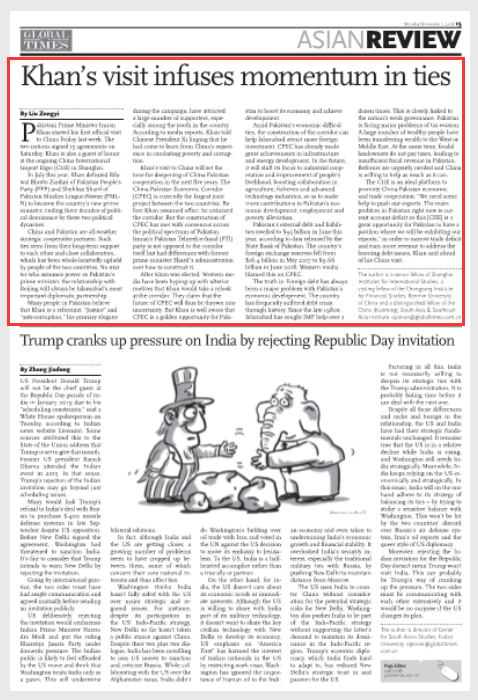Major Power Relations
Your Present Location: PROGRAMS> Major Power RelationsLiu Zongyi: Khan’s visit infuses momentum in ties
By Liu Zongyi Source: Global Times Published: 2018-11-04
Pakistani Prime Minister Imran Khan started his first official visit to China Friday last week. The two nations signed 15 agreements on Saturday. Khan is also a guest of honor at the ongoing China International Import Expo (CIIE) in Shanghai.
In July this year, Khan defeated Bilawal Bhutto Zardari of Pakistan People's Party (PPP) and Shehbaz Sharif of Pakistan Muslim League-Nawaz (PML-N) to become the country's new prime minister, ending three decades of political dominance by these two political dynasties.

China and Pakistan are all-weather strategic cooperative partners. Such ties stem from their long-term support to each other and close collaboration, which has been whole-heartedly upheld by people of the two countries. No matter who assumes power as Pakistan's prime minister, the relationship with Beijing will always be Islamabad's most important diplomatic partnership.
Many people in Pakistan believe that Khan is a reformist. "Justice" and "anti-corruption," his primary slogans during the campaign, have attracted a large number of supporters, especially among the youth in the country. According to media reports, Khan told Chinese President Xi Jinping that he had come to learn from China's experience in combating poverty and corruption.
Khan's visit to China will set the tone for deepening of China-Pakistan cooperation in the next five years. The China-Pakistan Economic Corridor (CPEC) is currently the largest joint project between the two countries. Before Khan assumed office, he criticized the corridor. But the construction of CPEC has met with consensus across the political spectrum of Pakistan. Imran's Pakistan Tehreek-e-Insaf (PTI) party is not opposed to the corridor itself but had differences with former prime minister Sharif's administration over how to construct it.
After Khan was elected, Western media have been hyping up with ulterior motives that Khan would take a relook at the corridor. They claim that the future of CPEC will thus be thrown into uncertainty. But Khan is well aware that CPEC is a golden opportunity for Pakistan to boost its economy and achieve development.
Amid Pakistan's economic difficulties, the construction of the corridor can help Islamabad attract more foreign investment. CPEC has already made great achievements in infrastructure and energy development. In the future, it will shift its focus to industrial cooperation and improvement of people's livelihood, boosting collaboration in agriculture, fisheries and advanced technology industries, so as to make more contributions to Pakistan's economic development, employment and poverty alleviation.
Pakistan's external debt and liabilities swelled to $95 billion in June this year, according to data released by the State Bank of Pakistan. The country's foreign exchange reserves fell from $16.4 billion in May 2017 to $9.66 billion in June 2018. Western media blamed this on CPEC.
The truth is: Foreign debt has always been a major problem with Pakistan's economic development. The country has frequently suffered debt crisis through history. Since the late 1980s, Islamabad has sought IMF help over a dozen times. This is closely linked to the nation's weak governance. Pakistan is facing major problems of tax evasion. A large number of wealthy people have been transferring wealth to the West or Middle East. At the same time, feudal landowners do not pay taxes, leading to insufficient fiscal revenue in Pakistan. Reforms are urgently needed and China is willing to help as much as it can.
The CIIE is an ideal platform to promote China-Pakistan economic and trade cooperation. "We need some help to push our exports. The main problem in Pakistan right now is current account deficit so this [CIIE] is a great opportunity for Pakistan to have a pavilion where we will be exhibiting our exports," in order to narrow trade deficit and earn more revenue to address the looming debt issues, Khan said ahead of his China visit.
The author is a visiting fellow of the Chongyang Institute for Financial Studies at Renmin University of China.























































































 京公网安备 11010802037854号
京公网安备 11010802037854号





